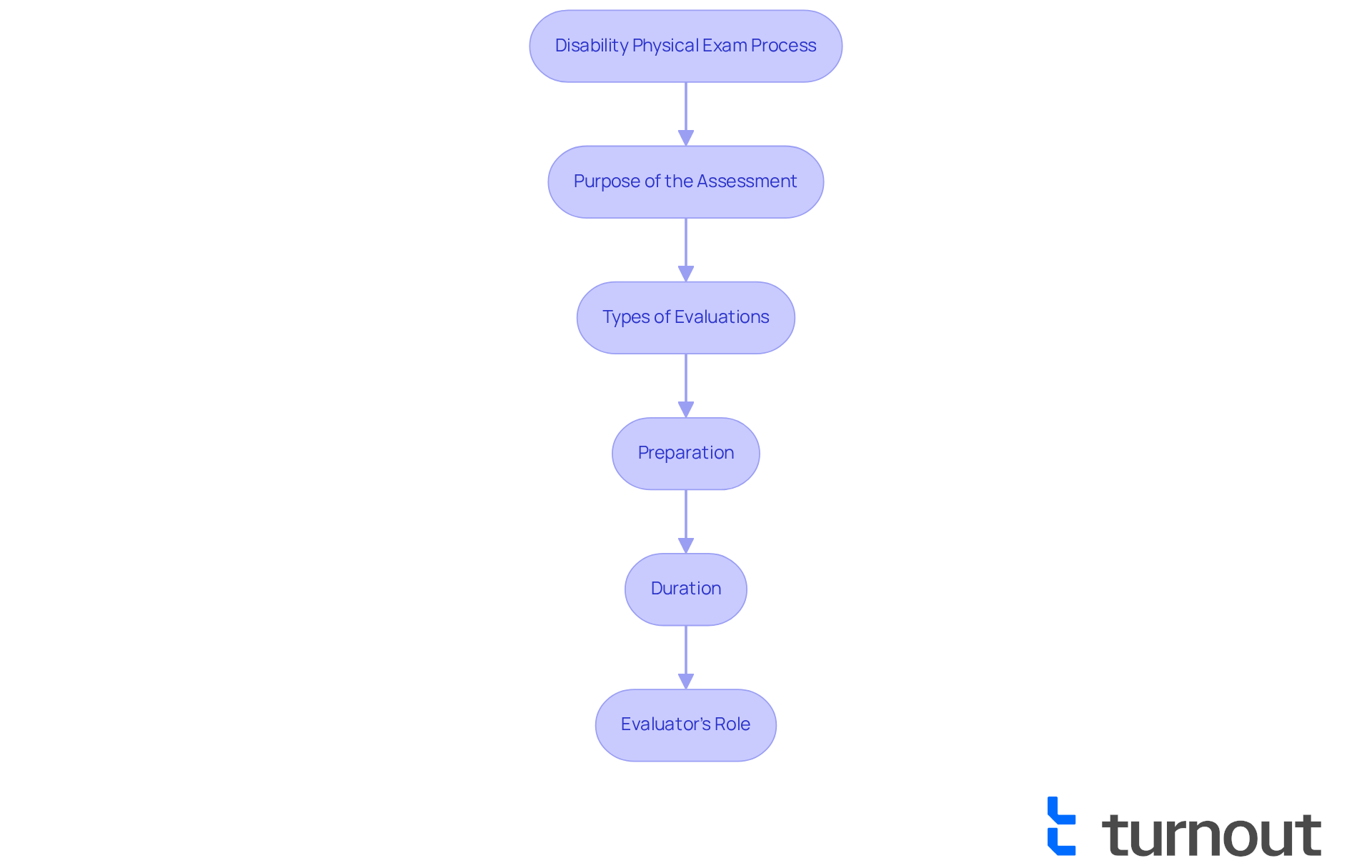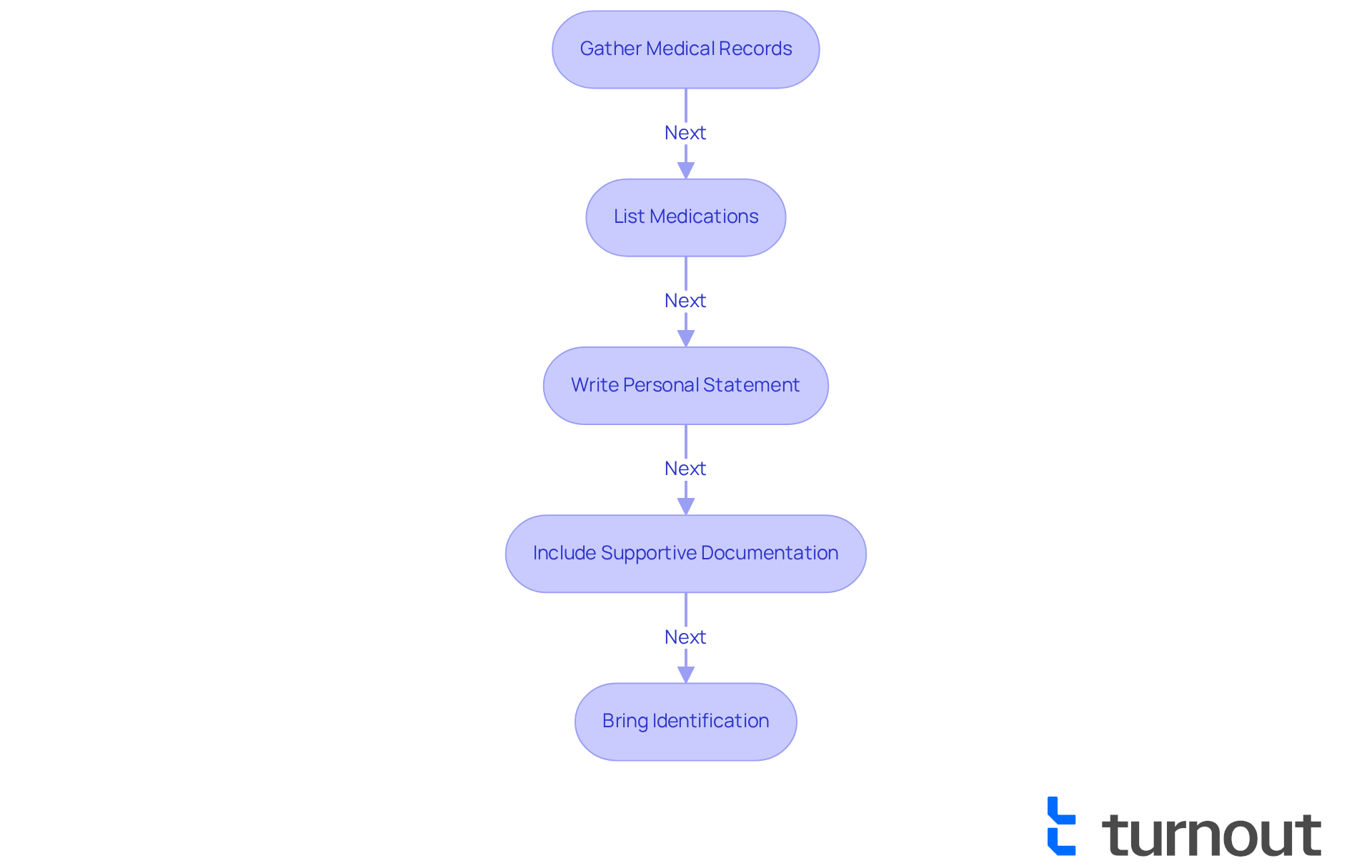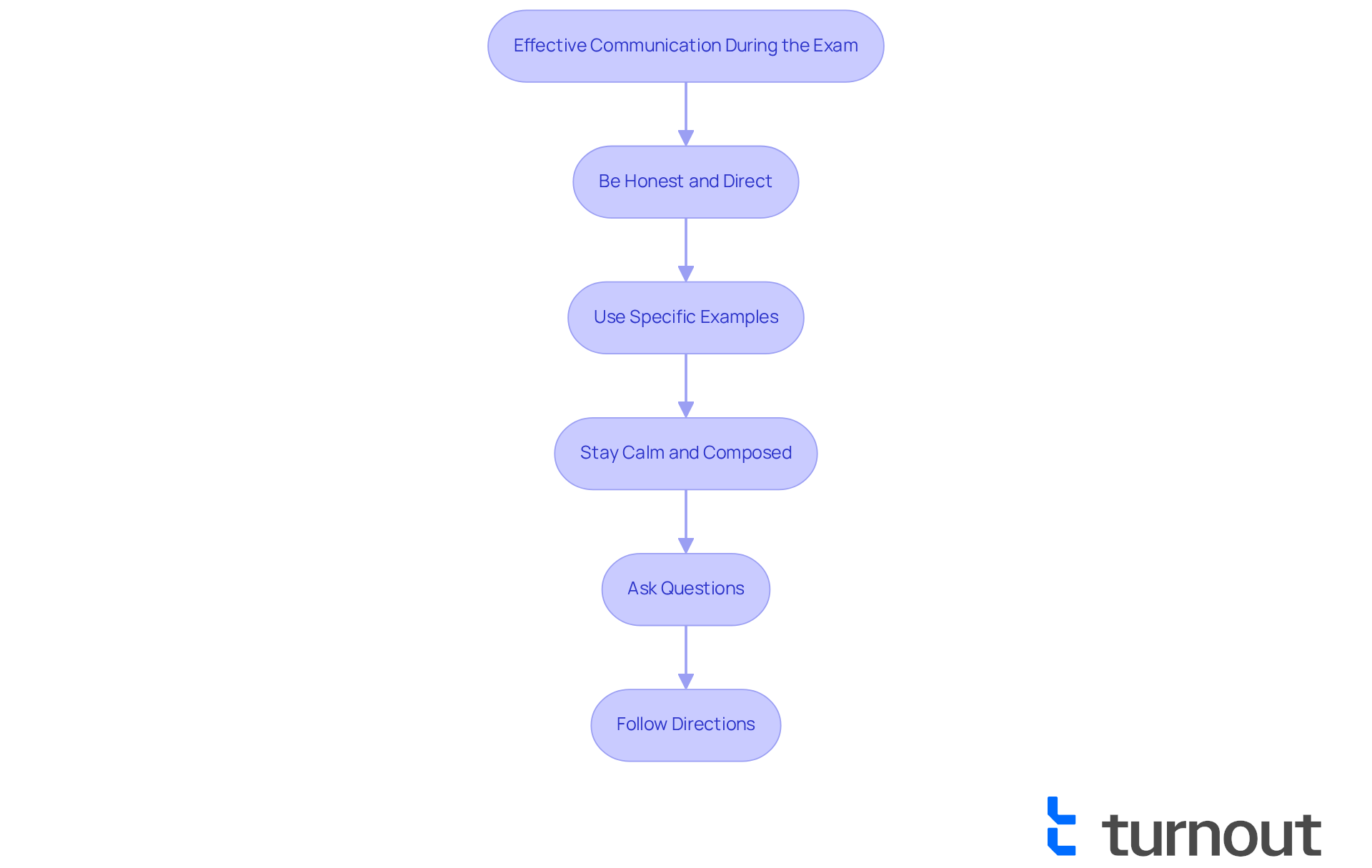Overview
Preparing for your disability physical exam can feel overwhelming. We understand that this process may bring up many emotions and concerns. To navigate it successfully, thorough preparation is essential. This includes:
- Understanding the assessment process
- Organizing necessary documentation
- Communicating effectively during the evaluation
Clear communication is vital. It’s important to express your experiences honestly and provide specific examples of how your disability impacts your daily life. This approach helps the evaluator to accurately assess your condition, ensuring that your claim for benefits is supported.
Remember, you are not alone in this journey. Many individuals face similar challenges, and it’s common to feel uncertain. By preparing well and sharing your story, you can help the evaluator understand your unique situation better.
Take a moment to gather your thoughts and documents. Reflect on your daily experiences and how your disability affects them. With this preparation, you can approach your exam with confidence, knowing that you have done your best to communicate your needs.
Introduction
Navigating the complexities of a disability physical exam can feel overwhelming for many applicants. It’s common to experience uncertainty and anxiety during this process. Understanding the intricacies of this assessment is crucial, as it plays a pivotal role in determining eligibility for essential benefits.
What strategies can individuals employ to prepare for this critical evaluation and enhance their chances of success? We’re here to help you explore the essential steps and insights needed to master the disability physical exam process. By empowering yourself with knowledge, you can approach your assessment with confidence and clarity.
Understand the Disability Physical Exam Process
Navigating the disability assessment can feel overwhelming, but understanding how to pass the disability physical exam is the first step towards securing the benefits you deserve. This assessment is a vital part of your application process, focusing on how to pass disability physical exam by evaluating how your physical and mental health conditions affect your daily life and ability to work.
-
What is the Purpose of the Assessment?
The assessment aims to measure the extent of your disability and its impact on your everyday activities. -
What Types of Evaluations Can You Expect?
You might encounter a combination of physical examinations, reviews of your medical history, and possibly psychological assessments, depending on your claimed conditions. -
What Should You Prepare For?
Familiarizing yourself with the assessment format can ease your anxiety. Expect to answer questions and learn how to pass the disability physical exam, which involves physical tests such as mobility tests, strength assessments, and evaluations of your range of motion. -
How Long Will It Take?
The assessment duration can vary significantly, lasting anywhere from 30 minutes to several hours based on the complexity of your case. -
What is the Evaluator's Role?
The evaluator will carefully document their observations and provide a report to the Social Security Administration (SSA). This report is crucial in the decision-making process regarding your benefits.
We understand that this journey can be challenging, but by preparing for these aspects, you can approach the assessment with greater confidence and clarity. Remember, you are not alone in this process, and we’re here to help.

Prepare Essential Documentation and Information
To ensure a smooth evaluation process, it’s important to gather the following essential documentation:
-
Medical Records: Compile all relevant medical records, including diagnoses, treatment history, and ongoing care plans. Make sure these documents are up-to-date and comprehensive, as strong medical evidence is crucial for your claim's success. We understand that many applicants fail to provide necessary documentation, which can lead to delays or denials. In fact, statistics show that a significant percentage of applicants do not submit all required documents. This underscores the importance of thorough preparation.
-
List of Medications: Provide a detailed list of all medications you are currently taking, including dosages and prescribing doctors. This information helps examiners understand your treatment regimen and its impact on your condition.
-
Personal Statement: Write a personal statement outlining how your disability affects your daily life, including specific examples of limitations you face. This subjective information can significantly influence the evaluation process.
-
Supportive Documentation: Include any additional documents that support your claim, such as letters from healthcare providers, therapists, or family members detailing your condition and its impact. Comprehensive documentation can strengthen your case and provide clearer evidence for the assessment.
-
Identification: Bring a valid form of ID, such as a driver’s license or state ID, to confirm your identity during the assessment.
Organizing these documents in a folder can help you present them clearly and efficiently during your evaluation. It’s advisable to organize medical records by date and provider for easier submission of additional evidence if needed later. Remember to request your medical records early to avoid delays in your application. The more thorough and organized your documentation regarding how to pass disability physical exam, the better your chances of a successful outcome. Consider obtaining a Medical Source Statement (MSS) from your treating physician to detail your diagnosis and treatment history, as this can be crucial for your claim.
We’re here to help you navigate this process, and you are not alone in this journey.

Communicate Effectively During the Exam
During the assessment, clear communication is essential. We understand that this can be a challenging experience, and we’re here to help you navigate it. Here are some strategies to ensure you convey your situation effectively:
- Be Honest and Direct: Answer all questions truthfully and provide detailed responses. If you don’t understand a question, it’s perfectly okay to ask for clarification.
- Use Specific Examples: When discussing your limitations, share specific examples that illustrate how your disability affects your daily life. For instance, consider describing how your condition impacts your ability to perform tasks at home or work.
- Stay Calm and Composed: It’s common to feel anxious, but try to remain calm. Take deep breaths if you feel overwhelmed, and allow yourself the time to respond thoughtfully to questions.
- Ask Questions: If you have concerns about the exam or the process, don’t hesitate to reach out to the evaluator. This shows your engagement and can help clarify any uncertainties you may have.
- Follow Directions: Pay close attention to the evaluator’s instructions during fitness tests. Adhering to these directions diligently will ensure precise assessments.
By communicating effectively, you can help the evaluator understand how to pass the disability physical exam by gaining a comprehensive understanding of your condition. Remember, you are not alone in this journey, and your voice matters.

Follow Up After the Exam for Optimal Results
After your disability physical exam, taking the following steps is crucial for achieving optimal results:
-
It's important to obtain a copy of the evaluator’s report to understand how to pass disability physical exam. This document not only provides valuable insights into the results of your assessment but also serves as an important record for your application. We understand that obtaining this report can be essential; it may provide information on how to pass disability physical exam, which could assist in your appeal.
-
Check Submission Status: Follow up with the relevant agency to verify that your exam results and any additional documentation have been received and are being processed. As of 2025, applicants can easily check their status through online portals or by contacting the agency directly.
-
Stay Informed: Regularly monitor your application status and be proactive in responding to any requests for further information from the agency. Clear status updates are now available, helping you understand your claim's progress.
-
Consult with your advocate to understand how to pass disability physical exam: If you have an advocate or support person, discuss the results and next steps with them. Turnout employs skilled non-legal advocates who can assist you in navigating the steps efficiently and preparing for what follows. It's important to note that Turnout is not a law firm, and the advocates do not provide legal representation.
-
Be Patient but Persistent: We know the review process can be lengthy, with applicants currently waiting an average of over seven months and fifteen days for a decision. While patience is essential, do not hesitate to reach out if you notice delays or have concerns about your application.
Statistics indicate that about 38% of applicants who meet technical requirements are accepted initially, but this figure rises to 53% for those who appeal their decisions. By diligently following up, you can help ensure that your application is processed smoothly and efficiently. Remember, around 10,000 applicants die and 8,000 file for bankruptcy while waiting for a decision, underscoring the urgency of staying proactive in your follow-up efforts.

Conclusion
Navigating the disability physical exam can feel overwhelming. We understand that this experience may be daunting, but grasping its intricacies is essential for securing the benefits that are rightfully yours. By familiarizing yourself with the assessment process, preparing the necessary documentation, and communicating effectively during the exam, you can enhance your chances of a successful outcome.
It's crucial to prepare your medical records comprehensively. Being honest and direct in your communication is equally important. Don't forget to follow up diligently after the exam. Each step, from preparation to post-exam actions, plays a critical role in demonstrating the extent of your disability and its impact on your daily life.
Ultimately, this journey is not just about passing the exam; it's about advocating for yourself and ensuring that your needs are recognized and addressed. By taking proactive steps and remaining informed throughout the process, you can navigate this challenging landscape with confidence. Remember, empowerment through preparation and communication can lead to the successful acquisition of the benefits needed to support a better quality of life. You are not alone in this journey; we’re here to help you every step of the way.
Frequently Asked Questions
What is the purpose of the disability physical exam assessment?
The purpose of the assessment is to measure the extent of your disability and its impact on your everyday activities.
What types of evaluations can I expect during the assessment?
You can expect a combination of physical examinations, reviews of your medical history, and possibly psychological assessments, depending on your claimed conditions.
How should I prepare for the disability physical exam?
Familiarizing yourself with the assessment format can help ease anxiety. You should expect to answer questions and undergo physical tests such as mobility tests, strength assessments, and evaluations of your range of motion.
How long does the disability physical exam typically take?
The duration of the assessment can vary significantly, lasting anywhere from 30 minutes to several hours based on the complexity of your case.
What is the role of the evaluator during the assessment?
The evaluator will carefully document their observations and provide a report to the Social Security Administration (SSA), which is crucial in the decision-making process regarding your benefits.




